Stainless steel forging is a metal-forming process that converts raw stainless steel material into high-strength, corrosion-resistant components. It includes shaping metal at elevated temperatures and optimizing material plasticity. The process begins with a thorough raw material examination and continues with die design, forging under controlled conditions, and post-forging operations like heat treatment.
Quality control measures, such as non-destructive testing and dimensional inspection, assure dimensional accuracy, surface finish, and material integrity in stainless steel forging. Stainless steel forging is widely utilized in a variety of industries, including automotive, aerospace, and energy, and creates components noted for their durability, strength, and resilience to severe environments.
Quality Control in Stainless Steel Forging
Stainless steel forging is an important manufacturing process that turns raw materials into high-strength, corrosion-resistant components. Quality control is essential at every stage of the forging process to achieve strict industry requirements and customer expectations. This article delves into the tactics and procedures used to maintain high quality in stainless steel forging.
Raw Material Inspection
A comprehensive analysis of the raw materials is the first step in quality control. The quality of the input material has a considerable impact on the end product in stainless steel forging. Stainless steel bars, billets, and ingots are thoroughly inspected by manufacturers for chemical composition, grain size, and surface flaws. Only stainless steel alloys that meet specific criteria are forwarded to the forging step.
Die Design and Preparation
Forging die design and preparation are essential parts of quality control. Precision die design guarantees that stainless steel components are accurately shaped while minimizing flaws. Die materials are selected for their longevity and resistance to wear, which is critical for maintaining dimensional accuracy and surface polish during several forging cycles.
Forging Process Monitoring
To discover irregularities and ensure consistency, the forging process must be monitored in real-time. Temperature control, forging speed, and applied pressure are all continuously monitored to avoid overheating, under-forging, or other faults that could jeopardize the stainless steel components’ integrity.
Heat Treatment Verification
Heat treatment is commonly used to improve the mechanical properties of stainless steel. Quality control techniques include ensuring that heat treatment processes adhere to prescribed parameters such as temperature, holding time, and quenching methods. This guarantees that the forged stainless steel components have the appropriate hardness, strength, and corrosion resistance.
Dimensional Inspection
Precision in dimensions is critical for stainless steel components, especially in applications requiring tight tolerances. The dimensional inspection entails measuring the final forged components against the prescribed design dimensions with specialized tools and processes.
Non-Destructive Testing (NDT)
Non-destructive testing is used to uncover internal flaws or irregularities without jeopardizing the stainless steel components’ integrity. Ultrasonic testing, magnetic particle inspection, and dye penetrant testing are used to check that there are no fractures, voids, or other problems.
Surface Finish and Visual Inspection
Stainless steel component aesthetics and surface polish are vital, especially in situations where appearance is important. Visual inspection, in conjunction with surface finish measurement instruments, verifies that the forged components fulfill the prescribed smoothness, cleanliness, and overall appearance standards.
Chemical Analysis and Material Verification
The corrosion resistance of stainless steel is determined by the alloy composition. Post-forging chemical analysis assures that the stainless steel components preserve the desired material qualities, such as corrosion resistance and conformity with industry standards.
Documentation and Traceability
Maintaining thorough documentation and traceability is critical to quality control. Each forged stainless steel component is given a unique identification number, and records are rigorously kept throughout the manufacturing process. This documentation facilitates quality audits, regulatory compliance, and programs for continuous improvement.
Continuous Improvement and Corrective Actions
Iterative quality control is used in stainless steel forging. Continuous improvement is aided by regular audits, feedback methods, and adherence to industry standards. Any deviations or nonconformities discovered during quality control processes initiate corrective steps to address root causes and avoid recurrence.
Remarks
Quality control in stainless steel forging is a broad and multifaceted process that includes everything from raw material inspection to final paperwork and component traceability. Manufacturers may ensure that forged stainless steel components satisfy the highest quality standards by applying stringent processes. This dedication to quality not only improves the performance and dependability of stainless steel products but also instills trust in consumers and end-users across a wide range of industries.
